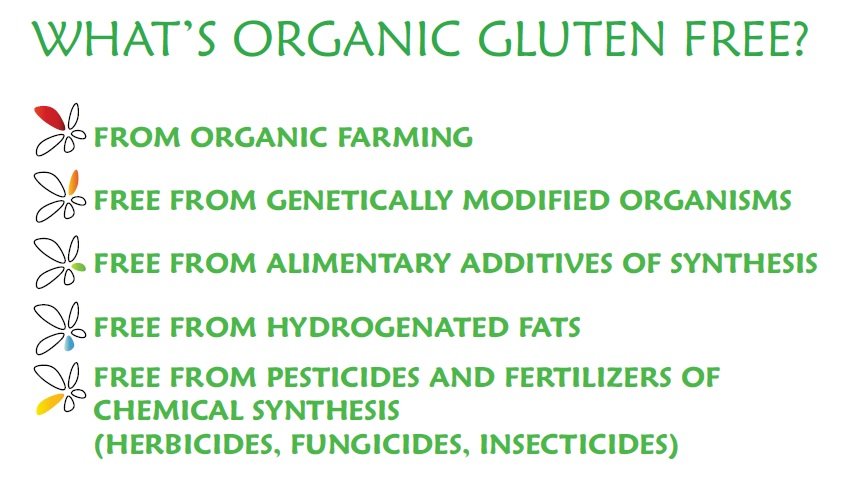
Celiac desease is nowadays well known by most of the consumers and now so many products exist on the market dedicated to this particular area. For those who still didn’t have a close encounter with this problem, celiac is a disease closely related to food: the body of many consumers, in fact, is not able to tolerate gluten content in various foods such as wheat, barley, kamut ®, spelled and rye, which its intake, even in small doses, causes severe damage to the intestinal mucosa and malabsorption syndrome.
The only treatment currently available is a gluten-free diet, basing your diet on grains that are devoid such as rice, corn, quinoa, millet and buckwheat (which is not a true grain, but that can be used as such). The number of subjects in Italian celiac disease is on the increase: it is estimated that about 1% of the population has celiac but, to date, only about 100,000 people have found to be suffering from this disease; about 500,000 more people would be celiacs, without it having been diagnosed them; over 4 years, the number of confirmed celiacs has doubled.
With a certain frequency, then, there is a link between gluten intolerance and other, for example lactose, egg, soy, creating many difficulties in finding products for the patient with these multiple intolerances.
The origin of the disease is very far: the first mention dates back to the first century AD, by Aulus Cornelius Celsus, a Roman physician, who introduced the term koiliakos (from the greek "those who suffer in the intestines") to indicate who was suffering from these disorders. For the first definition of celiac disease as "intestinal malabsorption syndrome", it took until the late 1800s, when the British physician Samuel Gee published his work "The Coeliac Affection," in which the therapy was possible for the first once you have identified in your diet without flour.
During the Second World War, Dicke observed an improvement of the conditions of his young patients who suffered from chronic diarrhea associated with intestinal malabsorption when, between 1944 and 1945, there was the so-called "winter fasting." Because of the conflict stocks of flour were exhausted, and children who followed were fed with potatoes, bananas, even with tulip bulbs. After the war and the return to a normal food availability, Dicke noticed a recurrence of the symptoms and then taking them correlated with flour containing gluten.
1900 was also the century of great agricultural selections; some scholars think that the incessant crossing of grain to generate species with high productivity, disease-resistant and with low ears (cheaper to collect) has led to the production of a cereal that, while it makes more other is less tolerated by the body, that "rebels" by allergies and gluten intolerance, its main protein.
In the vast panorama of gluten-free products, the patient looks puzzled and sometimes dejected, convinced that his diet will be distorted by products not tasty and unappetizing. In fact, soon changes his mind, finding great products from the organoleptic point of view, but the ingredients? The nutritional quality? And yet what makes these products so good, despite the absence of gluten? The answer lies in simply reading the list of ingredients listed on the package (an operation we recommend as always, even to non-celiacs).
Here's what may contain the conventional (non-organic) gluten-free products:
Food additives: these dyes, preservatives, antioxidants, acidity regulators, thickeners, emulsifiers, flavor enhancers, stabilizers, and so on, not to mention the aromas. In conventional gluten-free products is frequent the use of additives that perform the important function of giving consistency and firmness to products that otherwise would not have, because deprived of the natural "glue" that is gluten. Only a fraction of these substances is permitted in organic products; they are nevertheless substances extracted from natural products such as guar gum, carrageenan, xanthan gum.
GMO: gluten-free products are often obtained by using as main ingredients corn or soybeans. These are two of the crops at greater risk of GMOs (check the label carefully: it is necessary to indicate its presence when it is higher than 0.9%). In the organic the use of GMO ingredients is absolutely prohibited, and companies regularly test to ensure that they are not entered into the production cycle.
Hydrogenated fats: their use involves an important improvement in the consistency, with the hydrogenation fats are obtained that remain solid at room temperature (more convenient to store) and with characteristics of compactness very similar to those of butter, which make the product substantial without gluten. Hydrogenation is a chemical process by which polyunsaturated fatty acids are rendered partially saturated, which in the human body increases the risk of cardiovascular disease. In organic production have never been allowed; in their place is given ample space to noble oils such as extra virgin olive oil or sunflower with nutritional characteristics even comparable.
Several studies on the nutritional quality of the products on the European market (for example, the study by Dr. Arendt, University College Cork, Ireland), show the following average characteristics of gluten-free products compared to products with gluten: excessive use of fat (especially saturated fats, hydrogenated, trans), excessive caloric intake, excessive use of simple sugars (sucrose, common white sugar), excessive use of salt, lack of certain vitamins and some mineral salts, lack of fiber.
At the international conference on celiac disease, which was held in March 2012 in Florence, was put under accusation the unbalanced composition of foods for celiacs, which may lead to an increased incidence of diseases such as obesity, diabetes and cardiovascular disorders.
Choose an organic product protects us from the abuse of synthetic chemicals in our diet. Read the label carefully and evaluate the quality of the ingredients are necessary conditions for an informed purchase.
Once again favor the purchase of an organic product, it makes the difference.





